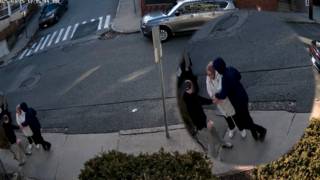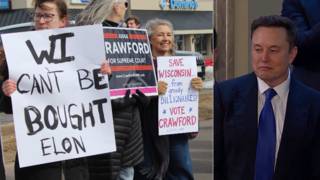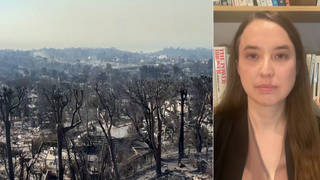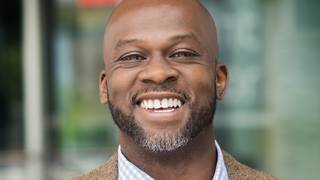
Guests
- Noah Diffenbaughsenior fellow at the Stanford Woods Institute for the Environment and an associate professor in environmental Earth system science.
- Mark Jacobsonprofessor of civil and environmental engineering at Stanford University and the director of its Atmosphere/Energy Program. Jacobson is also the co-founder of The Solutions Project.
As California’s massive drought worsens, new mandatory water restrictions have just gone into effect, requiring residents to cut back water use by a net total of 25 percent. A new study by the University of California, Davis, finds that in 2015 alone, the drought will cost the state’s farmers and agricultural industry $2.7 billion and more than 18,000 jobs. The study notes: “The socioeconomic impacts of an extended drought, in 2016 and beyond, could be much more severe.” Meanwhile, the death toll from India’s heat wave has topped 2,300, making it the fifth deadliest heat wave on record. We speak to two leading climate scientists at Stanford University, Noah Diffenbaugh and Mark Jacobson.
Transcript
AMY GOODMAN: We’re broadcasting today from Stanford University in California—California, a state that’s now in its fourth straight year of drought. This week, new mandatory water restrictions went into effect, with residents required to cut back water use by a net total of 25 percent. Just Thursday, the U.S. Drought Monitor said a wet May, that led to greener pastures in some areas, failed to bring any relief, and, quote, “the sprouting of grasses will most likely provide extra fuel for early fall wildfires once the vegetation dies off this summer.”
Meanwhile, a new study by the University of California, Davis, finds that in 2015 alone, the drought will cost the state’s farmers and agricultural industry $2.7 billion and more than 18,000 jobs. The study noted, quote, “The socioeconomic impacts of an extended drought, in 2016 and beyond, could be much more severe.” All this comes as the death toll from an ongoing heat wave in India has topped 2,300, making it the fifth deadliest in recorded history. India’s Earth sciences minister, Harsh Vardhan, said, “It’s not just an unusually hot summer. It is climate change.”
Well, for more, we’re joined by two guests. Noah Diffenbaugh is a senior fellow at the Stanford Woods Institute for the Environment and an associate professor here at Stanford University in environmental Earth system science. He recently published a study that found a link between global warming and California’s historic drought. Also joining us is Mark Jacobson, professor of civil and environmental engineering at Stanford and the director of its Atmosphere/Energy Program. Mark Jacobson also is the founder—co-founder of The Solutions Project, which combines science, business and culture to develop and implement science-based clean energy plans for states and countries. And we’re going to talk about what those plans are for all 50 states.
But first to Noah Diffenbaugh. The connection between the drought and climate change?
NOAH DIFFENBAUGH: So we know that climate change can influence drought in a number of ways. And, you know, drought, it’s important to keep in mind, is really the effective moisture that’s available. So, a lot of people may think of drought, they think of how much is it raining. But really it’s the effective moisture. And heat in the atmosphere can really affect that moisture, how much moisture is available for crops, how much moisture is available in reservoirs, how much moisture is available in snowpack. And it does so in a few ways. It draws water out of soils, right? So, the hotter it is, the more evaporation there will be, the more transpiration from plants. That’s what we’re seeing with the U.S. Drought Monitor, is really the long-term effects over this drought of high temperatures. It also affects snow. And in California, about a third of our water storage is reliant on snowpack as a natural reservoir. We don’t have the concrete reservoirs to store enough water that California needs. We rely on that snowpack. And the hotter it is, the more precipitation falls as rain rather than snow, and the snow that does fall melts earlier in the year. And we are seeing those in California in this drought. And when we look over the long-term history of California, we’re seeing increasing occurrence of years in which there is both low rainfall and high temperature. And that’s when we know we have an elevated risk of drought.
AMY GOODMAN: Have you ever seen anything like this before?
NOAH DIFFENBAUGH: Well, I was born in 1974, so I was alive in the much-remembered 1976, 1977 drought. Something that’s interesting is that, one, a lot of our climate indicators show that this drought is more severe than any drought that’s happened in California’s recorded history; 120 years of recorded history, this is the most severe drought. And secondly, you know, a lot of people talk about population growth and development in California, and these have been really, really large over the last 30 or 40 years. But interestingly, statewide, our water use is pretty similar now compared to in 1976, '77. So we've actually become much more efficient at using water in California. And so we have a much larger population, but our total water usage is pretty similar. So it really is that, you know, this is a more severe drought from a climate perspective.
AMY GOODMAN: Mark Jacobson, can you talk about the drought in California and this record number of deaths in India, 2,300 people in the latest heat wave?
MARK JACOBSON: Well, there are a lot of impacts of climate change, or what we also call global warming. And global warming is really the increase in average temperatures over the whole globe. And someplace you get lower temperatures on average, but in more places you’ll get higher temperatures, you’ll get more extreme events. Mostly because the average temperature is higher, the extremes are mostly in the warming direction. So you’re going to get some places where you’ll have much higher temperatures than you’ll normally get. And in some of these places, you will have greater heat waves and more deaths as a result. Or you’ll have more drought, as well. And, you know, in some places, you do get cool temperatures, and sort of as some people who don’t believe in global warming or climate change will say, “Oh, why is it cold outside, if there’s global warming occurring?” And that is because you’re looking at the average over the globe when you’re talking about global warming, and so you do get both lower temperatures and higher temperatures, but you’ll get more cases of higher temperatures.
And these higher temperatures will result in greater heat stress on people, and that will—is one source of mortality. Another source of mortality is enhanced air pollution. Higher temperatures, on average, increase air pollution, but particularly where the air pollution is already bad. And that’s another source of mortality. Another source of mortality is greater extreme storminess. You’ll get greater extremes in severe weather, such as more intensive hurricanes, for example. And because you just—like, hurricanes are driven by warmer sea surface temperatures, and the ocean temperatures are warmer on average over the globe, and so you’ll get greater intensity of the hurricanes, although not necessarily greater number.
AMY GOODMAN: So what do you say, either of you, to Senator Inhofe, who takes a snowball and brings it onto the floor of the Senate and says, “You call this global warming?”
NOAH DIFFENBAUGH: Well, I think this is really a question about risk. And we’re seeing that in California. And so, one example is our drought here. And when we look back at the 120 years of observed record in California, what we see is temperature goes up, temperature goes down; precipitation goes up, precipitation goes down; drought indicators go up, they go down. But what we see very clearly is that there’s a much higher risk of drought when temperatures are high. So it takes low precipitation, but if that low precipitation coincides with warm temperatures, the risk that that low precipitation produces drought is about twice as high compared to cooler temperatures.
And what we’ve seen is California has gotten warmer and warmer and warmer. We’ve gone from a regime in which about half the years were warm, and half the years were cool, and half the years were wet, and half the years were dry, to, over the last two decades, 80 percent of the years have been warm. And what that means is we’ve seen twice as many drought years. We’ve seen double the percentage of low-precipitation years that end up producing drought. So that’s really risk. It’s really about the probabilities. And when we talk about the fingerprints of climate change, the fingerprints of climate change on extreme events, we’re really talking about risk. What’s the probability that these extreme events occur?
AMY GOODMAN: And do you see this as a one-off event in California, the drought, if it can be dealt with now?
NOAH DIFFENBAUGH: Well our research shows very clearly that the conditions that are producing this drought are becoming much more probable. We see that in the historical record. The conditions are becoming more likely in the historical record. We also see it when we look at climate model experiments. We can talk about climate model experiments if you want. We’d love to put the Earth in a lab and run all kinds of experiments on it, like you can do in a Petri dish. We’re not able to do that. We use climate models to run those experiments. But we see very clearly that we’re already on the cusp of really experiencing these kinds of conditions much more frequently. And in fact, even that United Nations target of two degrees Celsius that we’ve heard discussed in Copenhagen and since and in the run-up to Paris this fall, even at that two-degree level of global warming, California is likely to be in a regime where year after year we’re experiencing very warm or severely hot conditions. What that means is that we have a much higher risk that when there’s low precipitation, that it’s also going to be hot. And that’s exactly what we’re experiencing in this drought.
AMY GOODMAN: And talk about, Mark Jacobson, in India. When we talk about hot, what are the temperatures we’re talking about?
MARK JACOBSON: Well, and we look at it in terms of—well, degrees Celsius most of the world uses, but in Fahrenheit, the temperatures can get up to an extreme heat. You’re getting up to over 100 degrees in Fahrenheit for a quite severe—for a significant period of time. And so, it’s sustained over a period of time. That’s the problem, because if you just have a short, you know, one day of hot weather, it’s not going to cause a problem, but many days in a row can really increase mortality. And people most affected are those already weak, the elderly and those who are sick or otherwise are weak or have illness. So, the temperatures, though, are—have been sustained over periods of time, and so this is the main problem with—that you’ll find in any place where you’re impacted. And other places that are impacted would be like sub-Saharan Africa, for example, where you’ll have extreme heat events, where people already are on the verge of severe weather, and then you just increase the temperature just a little bit, and that causes a huge mortality as a result.
AMY GOODMAN: A lot of politicians who are climate deniers say this has been going on for a very long time. Professor Diffenbaugh, in 2013, you published a report that found climate change is on pace to occur 10 times faster than any change recorded in, what, 65 million years?
NOAH DIFFENBAUGH: Well, so, in that paper, we were looking at global-scale temperature change. So we were looking at global warming and the rate of global warming, if we look at the two-degree-C target that the United Nations is putting forward, if we look at four degrees C, which is really where we’re likely to end up if we continue along the emissions trajectory that we’ve been on as a globe. So four degrees in 100 years, we can look back at the historical record—when geologists look back at the sediments in the ocean and the rock record on land, look at fossils, what they find is that there certainly have been periods where there’s been four degrees of warming or 10 degrees of cooling, but these have happened over very long periods. So the most rapid warming that’s been seen since the extinction of the dinosaurs 65 million years ago was a period called the Eocene. It happened in the Eocene, and it was about 55 million years ago, a long time ago. And there was four or five degrees of warming, but it looks like it happened in about 10,000 years. So we’re talking about doing in a century what Earth has done in thousands of years. And that’s really the big difference for the global scale. We do know, looking back at that period in the Eocene, that it was a very different climate. There were alligators and palm trees inside the Arctic Circle. So, the palm trees kept up, because they had 10,000 years to do it. The alligators kept up; they had 10,000 years to do it. But we’re talking about an ice-free Arctic with temperatures that look a lot like coastal Florida. So—
AMY GOODMAN: Wait, wait. Say that again.
NOAH DIFFENBAUGH: Well, so, in that period, when—the last time that we saw this four degrees of warming, it happened over thousands of years, and it created a very different climate. So, if we look at the Arctic Ocean, we know that it was at least seasonally ice-free. So, no summer ice in the Arctic. And when geologists reconstruct those temperatures using the chemistry and looking at the fossils that were—of the plants that were there, they see that it looks a lot like coastal Florida does now. So, people who say Earth has been through this before, they’re right in terms of the magnitude of change, but the big difference is how rapid that change was. And we know from looking at those periods in the past that the climate was really, really different. So we’re not saying that Earth hasn’t experienced climate change before. What we’re saying is that we have very strong evidence that what we’re seeing now is due primarily to human activities and that the pace of change is much more rapid than what ecosystems have been exposed to in the recent geologic past.
AMY GOODMAN: We’re going to break, and when we come back, I want to talk about solutions, what is possible. Our guests are two climate scientists here at Stanford University, Noah Diffenbaugh and Mark Jacobson. And after we finish speaking to them, we’re going to Barcelona, Spain, for an exclusive broadcast interview with the mayor-elect of Barcelona, a leading anti-eviction housing activist who will be the first female mayor of that Spanish city. Stay with us.












Media Options